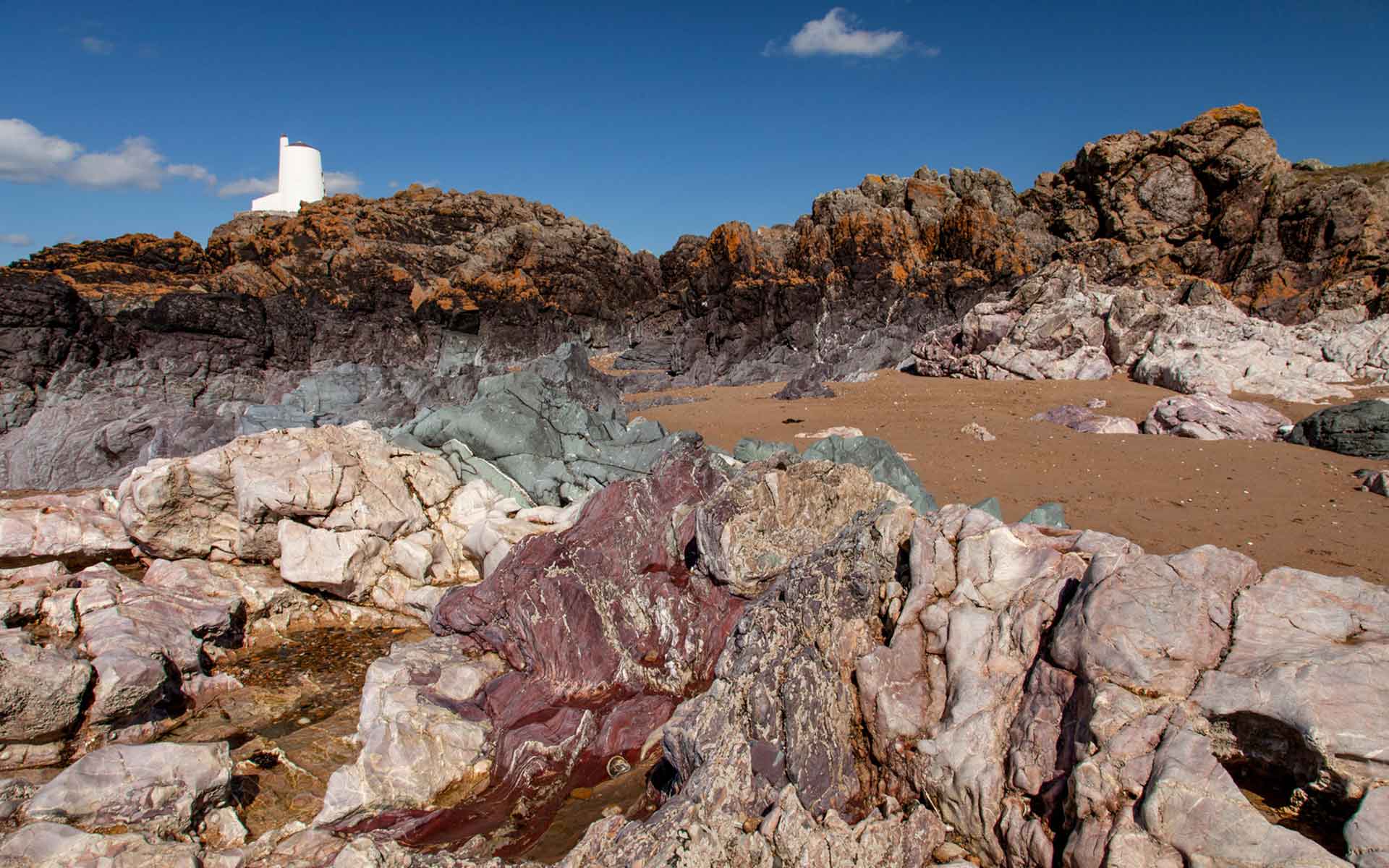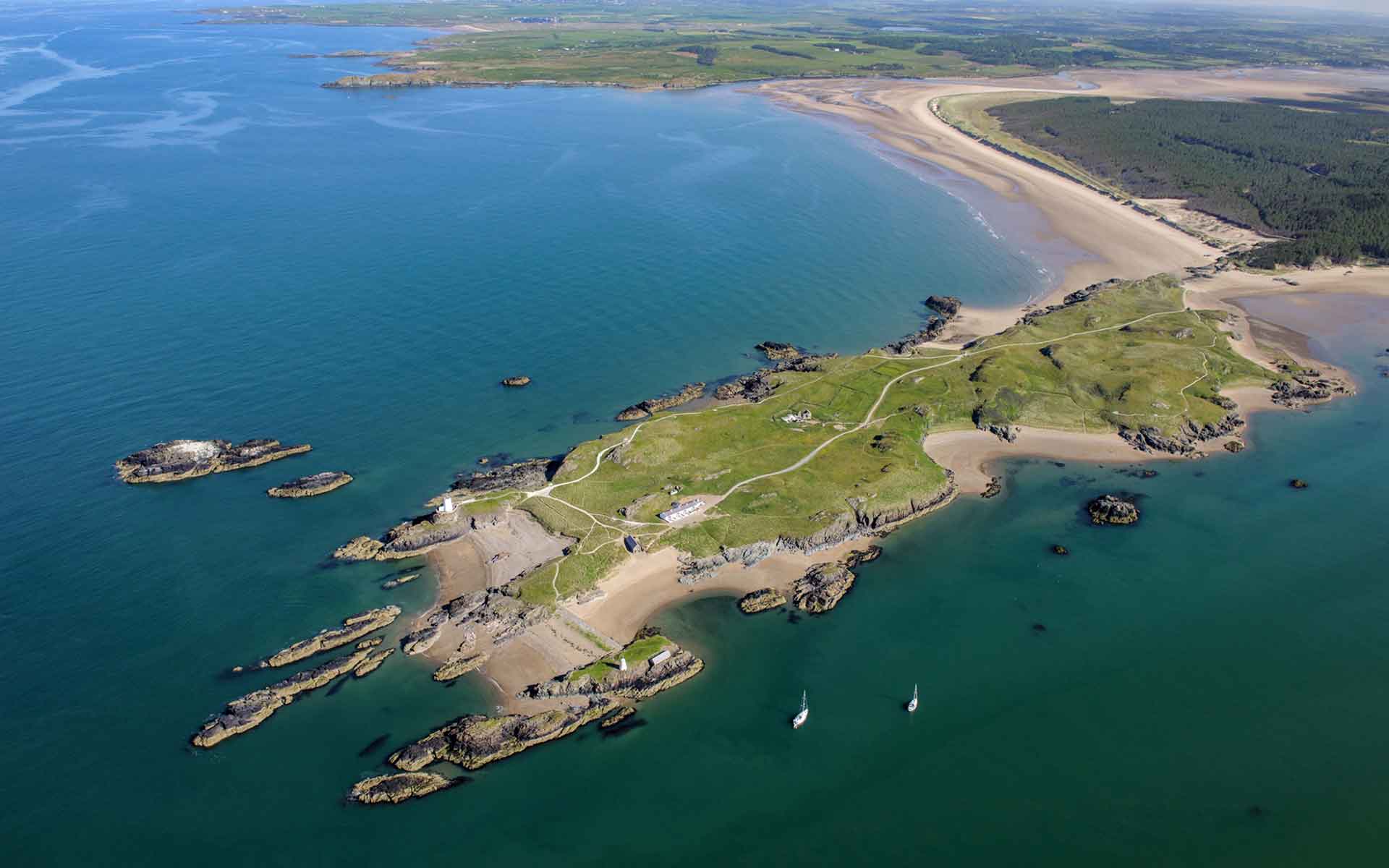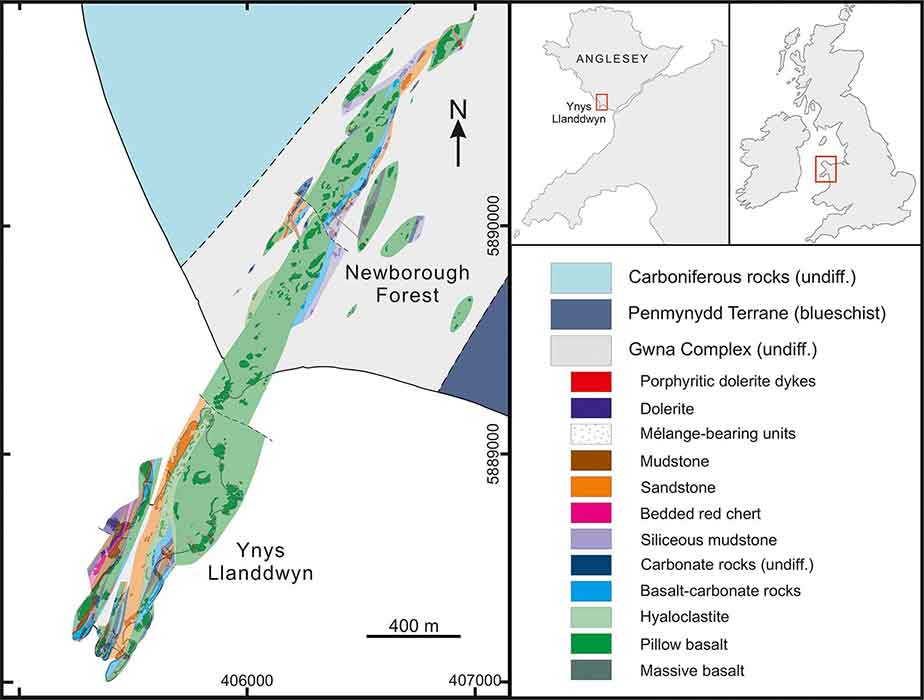
Late Neoproterozoic-Cambrian mélange at the southwest tip of Ynys Llanddwyn. (Photo: Stewart Campbell).
Geological Period
Late Neoproterozoic – Cambrian
Main geological interest
Tectonics History of geosciences
Igneous and metamorphic petrology
Location
Anglesey Geopark North Wales, UK.
53°08’19.0″N 4°24’39.0″W
Late Neoproterozoic-Cambrian mélange at the southwest tip of Ynys Llanddwyn. (Photo: Stewart Campbell).
Spectacular, accessible and well-preserved exposures of late Neoproterozoic/Cambrian mélange with more than 200 years of geological study.
Ynys Llanddwyn is globally significant as an historical reference site for mélange (Greenly, 1919) and for testing geological paradigms on the formation of mélangetype deposits. The MORB pillow lavas are globally significant as some of the oldest and best preserved – including finely crystalline chilled margins and cracked and pitted cooling surfaces. The site has a history of more than 200 years of geological research and has been used as critical evidence in numerous important regional and transcontinental geological syntheses and detailed studies (e.g. Gibbons and Horák, 1996; Schofield et al., 2020).
- Geological description
Ynys Llanddwyn featured in one of the first geological investigations and mapping exercises in the world (Henslow, 1822), and the term ‘mélange’ was first coined by Greenly (1919) for the mixture of rocks found on the western tip of the island. Rock exposures on and around Ynys Llanddwyn showcase some of the UK’s most important geology. Late Neoproterozoic-Cambrian rocks of both continental and oceanic settings belong to the Gwna Group (now the Bodorgan Formation (Schofield et al., 2020) and include pillow and massive basalt, hyaloclastite, carbonate and basalt-carbonate, chert, sandstone, mudstone and mélange-bearing units. These rocks are superbly exposed in coastal sections and outcrops that extend northeast from the southern tip of Ynys Llanddwyn across a tidal causeway into Newborough Forest. The assemblage is one of several mélanges preserved on Anglesey and northwest Llŷn, which are of controversial origin and of considerable ongoing research value. Debate continues as to whether these mélanges were formed entirely by tectonic emplacement, as part of an accretionary wedge or prism in a subduction zone, or if gravity slide or mass flow, mobilised by a catastrophic event such as continental shelf collapse, was a contributory process (Maruyama et al., 2010; Groome, 2022).
- Scientific research and tradition
Ynys Llanddwyn was studied by Henslow (1822) and was critical to Greenly’s (1919) pioneering work on Anglesey. Featuring in longrunning Japanese-British and BGS mapping/ research programmes (Maruyama et al., 2010; Schofield et al., 2020), it continues to attract field parties and international researchers testing new geological paradigms.
- Reference
Gibbons, W. and Horak, J.M. (1996) ‘The evolution of the Neoproterozoic Avalonian subduction system: Evidence from the British Isles’. Available at: https://doi.org/10.1130/0-8137-2304-3.269.
Greenly, E. (1919) The geology of Anglesey. London: H.M. Stationery Off.
Groome, N. (2022) Neoproterozoic-Ordovician Evolution of the Monian Subduction Complex, Wales, UK. Unpublished PhD thesis. University of Cardiff.
Henslow, J.S. (1822) Geological Description of Anglesea. (Transactions of the Cambridge Philosophical Society). Available at: http://archive.org/details/Henslow1822TransactionsOfTheCambridgePhilosophi
(Accessed: 2 August 2022).
Maruyama, S., Kawai, T. and Windley, B.F. (2010) ‘Ocean plate stratigraphy and its imbrication in an accretionary orogen: the Mona Complex, Anglesey–Lleyn, Wales, UK’, Geological Society, London, Special Publications, 338(1), pp. 55–75. Available at: https://doi.org/10.1144/SP338.4.
Schofield, D.I. et al. (2020) ‘Tectonic evolution of Anglesey and adjacent mainland North Wales’, Geological Society, London, Special Publications, 503(1), pp. 371–390. Available at: https://doi.org/10.1144/SP503-2020-9.
- Author(s)
Raymond Roberts
Natural Resources Wales, Chester Road, Buckley, CH7 3AJ
Stewart Campbell
Natural Resources Wales, Chester Road, Buckley, CH7 3AJ
Graham Williams
Natural Resources Wales, Chester Road, Buckley, CH7 3AJ
Niall Groome
School of Earth & Environmental Sciences, Cardiff University, Cardiff, CF10 3AT
David Buchs
School of Earth & Environmental Sciences, Cardiff University, Cardiff, CF10 3AT
Alan Holden
British Geological Survey, Cardiff University, Cardiff, CF10 3AT

